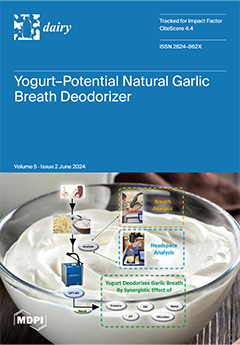Open AccessArticle
Nutritional Composition and Chemical Safety of Wagashi Gassirè Cheese Sold in the Southern Benin Markets
by
Alphonse Wanignon Dossou, Baké Marie Thérèse Seko Orou, Gwladys Komagbe, Philippe Sessou, Abdou Karim Issaka Youssao, Souaïbou Farougou, Joseph Djidjoho Hounhouigan, Jacques Mahillon, Roch Mongbo, Marc Poncelet, Samiha Boutaleb, Sylvie Gobert, Yann Eméric Madode, Paulin Azokpota, Antoine Clinquart, Marie-Louise Scippo and Caroline Douny
Cited by 2 | Viewed by 2802
Abstract
In this study, the nutritional composition and the chemical safety of Wagashi Gassirè (WG) cheese sold in southern Benin markets were assessed. For this purpose, 15 WG were analysed for fatty acids, essential minerals, and chemical hazards (dioxins, aflatoxin M1 (AFM1), biogenic amines,
[...] Read more.
In this study, the nutritional composition and the chemical safety of Wagashi Gassirè (WG) cheese sold in southern Benin markets were assessed. For this purpose, 15 WG were analysed for fatty acids, essential minerals, and chemical hazards (dioxins, aflatoxin M1 (AFM1), biogenic amines, metals, antibiotic and pesticide residues). The risks related to arsenic, lead, aluminium, AFM1, histamine, and tyramine were calculated using the methods recommended by the European Food Safety Authority. Oleic, palmitic and stearic acids, calcium, and phosphorus were the main fatty acids and minerals detected. Lead (0.08 ± 0.06 mg/kg) and AFM1 (0.3 ± 0.0 µg/kg) were detected in all samples and exceeded the maximum level set by the international standard. Cadaverine and tyramine were the main biogenic amines found. No pesticide residues were detected using a multi-residue method targeting compounds. Residues of quinolones, tetracyclines, and colistin antibiotics were also detected. The calculated chronic exposure indicated no public health concern for the chemical contaminants targeted. Moreover, the average cancer risk related to AFM1 intake was 3 × 10
−4 cases/10
5 persons/year for the Benin population through WG consumption. This study contributes to the nutritional characterization of WG and identifies lead and AFM1 as the most relevant chemical hazards of this product.
Full article
►▼
Show Figures





